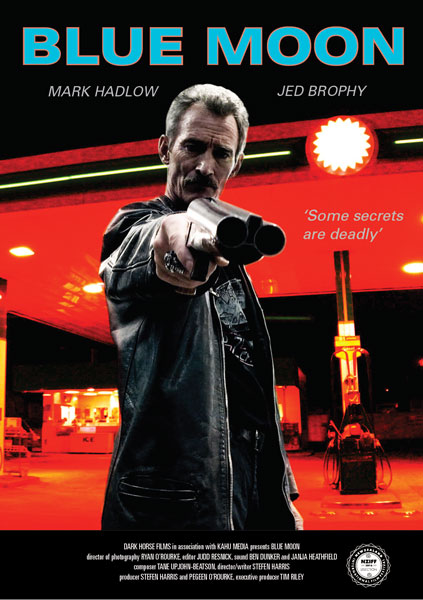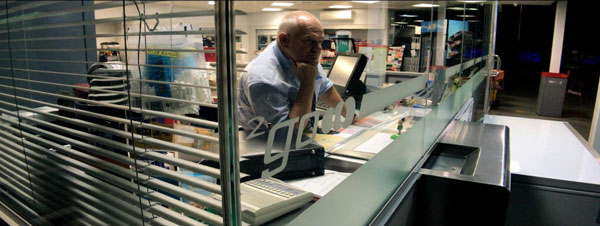“After years working as a front line police officer I became fascinated with the people of the night. The night cashiers, Cleaners, Taxi Drivers, Security Guards, the Police and the criminal underclass. Almost a separate species living a somnolent existence virtually a raw negative to our lives. I wanted to make a story entirely within that realm, using the night time almost as a thematic special effect.” Stef Harris, writer-director of Blue Moon.
Blue Moon is an 84 minute crime thriller set entirely in a gas station in Motueka, New Zealand. The film was shot on a very minimal budget using an iPhone and a gimbal and available lighting. The cinematography is beautifully composed and stylish, whilst at the same time identifiable as iPhone footage.
With the quality of smartphone filmmaking accelerating quickly, we wanted to know about how the film was made. So we interviewed the film’s director Stef Harris to find out more.
“What would you do if you had one chance to turn your life around? Would you steal half a million dollars if nobody in the world would ever know?” Blue Moon Tagline
What is the story behind your film?
Actors Mark and Jed and myself had often talked about making a feature film but the big hurdle was always the finance. I knew they were both excellent actors and I knew that they had a way of sparking off each other that would light up a screen. They both liked some of the stories I had been writing so all three of us knew we wanted to work together on a feature film project.
Every now and then someone would throw out the comment in frustration “let’s just do it on a phone!” This was said repeatedly over a couple of years and never taken seriously.
I was aware of various features that had been successfully made on cell-phones and began to wonder if that was a realistic possibility. I started to ask myself the question: if we were to make a film on a smartphone what would be our limitations? But I knew I needed a single location and a single time frame and a story that involved just the two actors.
What were the steps which led you to make it?
When I’m not writing books and movies I’m a front line uniformed police officer in New Zealand.
I was gassing up my patrol car at 4.20 am and I looked back at the petrol station. It was lit up like a spaceship. It put me in mind of 2001 Space odyssey.
I took my police issue iPhone out of my kevlar vest and took a shot. That photograph became the founding document of Blue Moon the movie. The next day I glued the picture to the inside cover of a 3B notebook. In the space of four hours I wrote an 8 page treatment and stuck that in the notebook too.
“If someone had donated a Red camera and a lighting truck it would have killed the project dead.”
Mark and Jed both loved the story and so we set a shoot date a year in advance. Over that time I raised a small budget of $12,000 for travel, accommodation and a catering budget to feed the crew. I wrote a new draft of the screenplay every month leading up to the shoot.
I worked the media, telling the local newspaper the good news that the first ever feature film was to be shot in our small town of Motueka. As a result film enthusiasts both professional and first timers came out of the woodwork to assist me.
A sound engineer who had recently worked on Quentin Tarantino’s Inglorious Basterds volunteered to take over the sound department. An Oscar winning set designer from Lord Of The Rings volunteered special FX help. A makeup artist from Weta Workshop also volunteered. The rest of the crew was made up of first time amateurs and experienced film makers all working for free.
We had the use of the gas station from midnight to 5am for six nights.
Why did you choose a smartphone to film with?
Initially smartphone was the answer to our financial woes. It meant that with just $12k cash I was able to say to everyone involved, “We have a green light and this is the shooting date.” However as we progressed I realised the smartphone was going to help us in so many other ways.
Because we were attempting to shoot an entire feature film in 6 five hour nights – a total of 30 hours – the iPhone was the perfect tool for a quick and simple shoot. If someone had donated a Red camera and a lighting truck it would have killed the project dead.
What equipment did you use?
I’m a writer director so much of the technical responsibility was offloaded to my cinematographer Ryan O’Rourke (another police Officer). It was Ryan who convinced me we could achieve a good result with iPhone.
We used iPhone 7+ shooting in 4K. With an Osmo gimbal. We used Filmic Pro. We had a Moondog Labs anamorphic lens. For the dolly shots we used an Ebike rickshaw. We had a drone pilot come shoot some aerial shots of the gas station too.
The edit was done on Avid by Judd Resnick. Judd had a career in Hollywood editing movie trailers before he came to live in New Zealand. I was lucky enough to meet him and persuaded him to come on board and cut our feature. Judd also cut our very sharp trailer, of course.
How much did you know about filmmaking before you made this film?
Before making this film I had made Super 8 movies as a teenager and a 24 minute Super 16mm film when I was 17 (that film was lost forever when the sound studio went bankrupt). I gave up film making for a while until 2006 when I made a digital feature on a broadcast video camera. That 101 minute feature film was The Waimate Conspiracy which won four best film awards in New Zealand Canada and Australia.
What did you like about filming with a phone? What were the downsides, if any?
I came to filmmaking as a writer first. As a director, I love the iPhone because it is so simple and fast. The actors were able to run long scenes, never having to stop for the camera to reset. We could get into tight spaces without intimidating the actors. You have to keep moving to keep it interesting. I’ve always loved hand held camera. I like to feel the image breathing and let the camera move naturally with the action.
Has making the film changed your life in any way?
Yes, it’s something I really wanted to do. It was a massive challenge and I feel very pleased with the result. It just makes me want to make another one.
How successful was the film, personally and in gaining an audience for your work?
Blue Moon was selected for the New Zealand International Film Festival which was an excellent result. We found a sales agent Oration Films in Los Angeles and Blue Moon is presently on the worldwide film festival circuit. So far selected for Houston International Film festival, MoziMotion Film Festival Netherlands, Mobile FilmMaker Film festival Moscow and Los Angeles Motion Picture Festival.
Looking back on the movie, is there anything you’d have done differently?
Well yeah, there are a few continuity clangers which I wish I had spotted at the time!
How important are film festivals that give these kind of films a platform for you?
Film festivals are a great way to have your work seen and reviewed and hopefully will lead to international sales. I hope to have Blue Moon on an online pay per view platform soon.

Eager to learn more?
Join our weekly newsletter featuring inspiring stories, no-budget filmmaking tips and comprehensive equipment reviews to help you turn your film projects into reality!
Simon Horrocks
Simon Horrocks is a screenwriter & filmmaker. His debut feature THIRD CONTACT was shot on a consumer camcorder and premiered at the BFI IMAX in 2013. His shot-on-smartphones sci-fi series SILENT EYE featured on Amazon Prime. He now runs a popular Patreon page which offers online courses for beginners, customised tips and more: www.patreon.com/SilentEye


